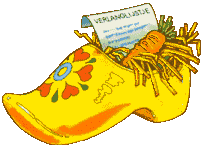In Ionad Bhur Stocaí … Paitíní Posted by róislín on Dec 12, 2011 in Irish Language
(le Róislín)
 Not everyone gets their stocking-fillers in a stocking (stoca). In some areas, notably An Ísiltír, clogs (“klompen” in Ollainnis, “sabots” i bhFraincis) are used. In Irish, the word “paitíní” suffices for both “clogs” and “pattens,” the latter word being the closer cognate. Getting your Christmas gift in a clog pertained to Lá San Nioclás (Dag Sinterklaas), i.e. 6 Mí na Nollag, not Oíche Nollag as such (24 Mí na Nollag) and not An Nollaig í féin (25 Mí na Nollag).
Not everyone gets their stocking-fillers in a stocking (stoca). In some areas, notably An Ísiltír, clogs (“klompen” in Ollainnis, “sabots” i bhFraincis) are used. In Irish, the word “paitíní” suffices for both “clogs” and “pattens,” the latter word being the closer cognate. Getting your Christmas gift in a clog pertained to Lá San Nioclás (Dag Sinterklaas), i.e. 6 Mí na Nollag, not Oíche Nollag as such (24 Mí na Nollag) and not An Nollaig í féin (25 Mí na Nollag).
It seems to me that “paitíní,” in the traditional sense are actually fairly different from clogs as I know them, either those found san Ísiltír and neighboring areas or the fashion ones (Swedish style, etc.), which have leather or vinyl uppers and have been intermittent fashion statements since the 1970s. I never quite got the knack of them myself. Is fearr liomsa bonn rubair!
Pattens, and “paitíní” in some senses of the word are typically meant to protect the shoe while walking through “clábar” (mud), etc. (N.B. an “etc.” sin – lathach, bualtrach agus a leithéid). With the Dutch and Swedish clogs, you don’t actually wear another shoe inside the clog – it is your shoe. Some designs of pattens have small four “legs,” about 3 inches high, kind of like mionmhionmhionchosa croise (N.B. not maidí croise, which are “crutches” for walking with a broken leg, etc.). Others have a small platform under the sole, but unlike most bróga bonnarda faisin, the platform does not meet the lasca. It’s a sort of toadstool shape, if you will.
“Paitíní” actually doesn’t seem like the greatest word to me to describe the klompen-style clog, but I don’t see anything else available per na foclóirí or in úsáid ghinearálta. I don’t think the traditional patten would do as good a job of holding féiríní beaga, since their sides are usually open, but I guess San Nioclás and his capall would manage.
Yes, I said “capall” (horse). Sinterklaas traditionally travels locally ar mhuin capaill (on horseback); his journey from Spain (with the Christmas oranges) is usually by bád, but believe me, sin scéal eile.
There is a nice reciprocity to the Dag Sinterklaas tradition. One leaves bia for the horse (meacan dearg, mar shampla, agus/nó féar tirim). In return, one receives small gifts like oráistí, milseáin (go mór mór iad déanta as prásóg almóinne), boinn seacláide, and these days, dearbháin bhronntanais (cartaí bronntanais). So, sa traidisiún seo, bia don chapall ach ní do Dhaidí na Nollag é féin. Ach sa traidisiún níos forleithne, mar shampla i Meiriceá, bia do Dhaidí na Nollag ach ní do na réinfhianna! Ar ndóigh, amanna do na réinfhianna freisin. Fuair mé mála beag de “bhia réinfhia” uair amháin ó mhac léinn. Cineál brioscaí madraí a bhí ann i ndáiríre, ach bhí an pacáiste gleoite agus an smaoineamh cliste.
And by the way, why not just use the English word “clog” in Irish for the shoe? Well, one could of course, as a focal iasachta, but it would trigger a homonym alert, since “clog” is already an existing Irish word meaning … (freagra thíos). SGF, Róislín
Freagra: “clog” in Irish means “clock” or “bell,” as in “a haon a chlog” (one o’clock) or “clogra” (a carillon or set of bells”) and “cloigíneach” (a bell-wether in the actual animal husbandry sense of the word)
Gluais: bonn, sole (of foot); bonn, a coin, a medal; bonnard, “platform” re: shoe, lit. high-soled (as opposed to “faoi shála arda,” high-heeled), “bonnard” is usually used in the plural, bonnarda; cos chroise, a stilt, lit. cross- or crosspiece-leg/foot, pl: cosa croise (note the disappearance of the lenition, with “ch-“reverting back to “c”); féar tirim, hay; forleathan, widespread; lasca, welt (n, of a shoe); meacan dearg, carrot (note the color term!); níos, more

Build vocabulary, practice pronunciation, and more with Transparent Language Online. Available anytime, anywhere, on any device.





Leave a comment: